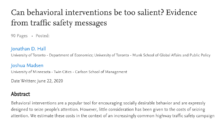By Jonathan Hall and Joshua Madsen
Behavioral interventions are a popular tool for encouraging socially desirable behavior and are expressly designed to seize people’s attention. However, little consideration has been given to the costs of seizing attention. We estimate these costs in the context of an increasingly common highway traffic safety campaign that displays roadside fatality counts on highway dynamic message signs (DMSs). We exploit detailed data on DMS and crash locations, DMS log files, and a unique setting in Texas where fatality messages are shown only during one week each month. We find that this behavioral intervention significantly increases the number of traffic crashes. The increase in crashes is immediate, dissipates over longer distances, and increases with the displayed fatality count. Furthermore, drivers do not habituate to these messages, even after five years, and the effects do not persist beyond the treated weeks. Crashes increase statewide during treated weeks, inconsistent with any benefits. Our results show that behavioral interventions, designed to be salient, can crowd out more important considerations, causing interventions to backfire with costly consequences.
